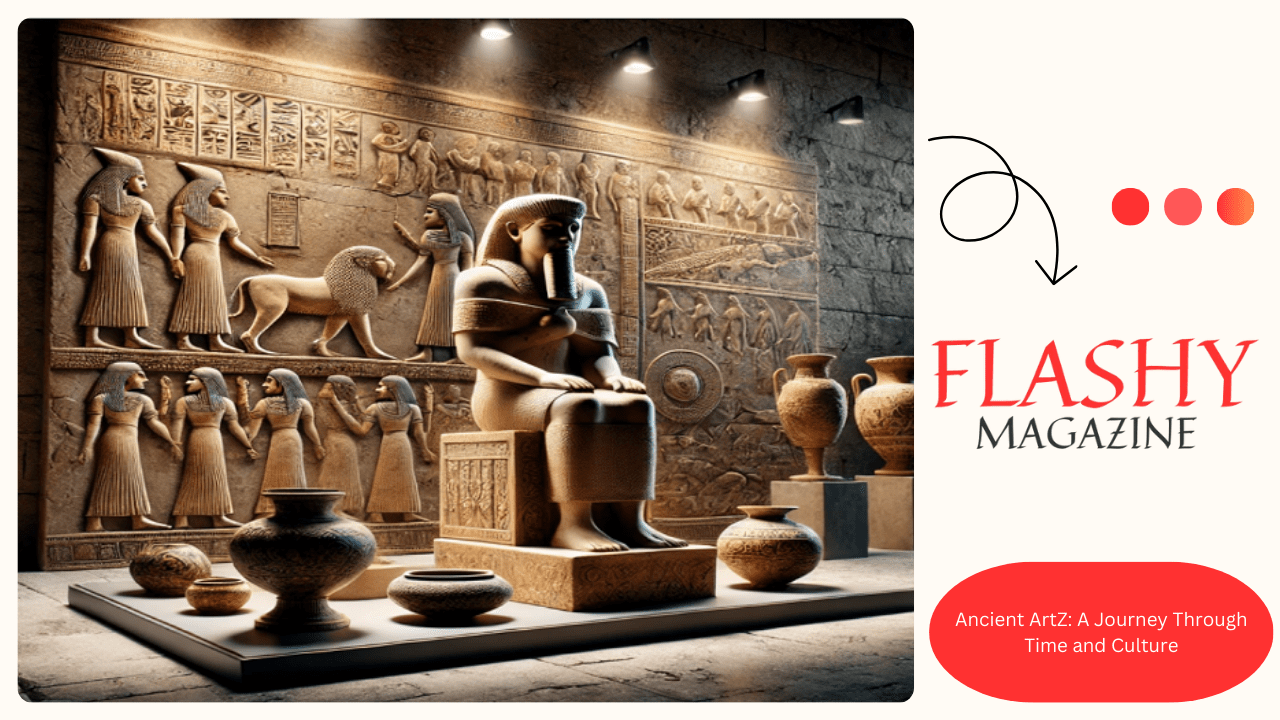The artz of ancient societies is like a time capsule, conserving the beliefs, creativity and diurnal lives of our ancestors. Ancient artz spans thousands of times, from delve oils to large puppets, with each piece telling a unique story. In this composition, we will claw deep into the rich history of ancient artz, exploring its origins, artistic significance, and the continuing impact it has had on ultramodern society.
An Preface to Ancient Artz
Ancient artz serves as a visual history of humanity, telling stories that written language occasionally can not express. It reflects not only the aesthetics of once societies, but also the values, beliefs and struggles of the people who created it. From gravestone tools etched with simple busts to large monuments similar as the conglomerations, ancient art offers a regard into our participated mortal history.
What Defines Ancient Artz?
Ancient art encompasses a wide range of cultural expressions, including form, pottery, oil, and armature created by societies before the fall of the Roman Empire in 476 announcement. Each piece bears distinct features that represent the culture, church and technological advancements of its time. Ancient art is not only a evidence to the artz of artists, but also a reflection of the mortal hunt for meaning and environment.
The Onsets of Ancient Artz
The origins of ancient artz can be traced back to the Stone Age, when the first humans began creating simple but emblematic pieces. These early workshop were frequently created from natural accoutrements similar as gravestone, complexion and bone. Over time, as societies developed, so did the complexity and purpose of their artworks. Ancient artz evolved along with social development, illustrating the close relationship between culture and creativity.
Early Cultural Expressions Neolithic Artz
Cave Oils
One of the oldest forms of ancient artz is set up in the form of delveoils, created as early as 30,000 times agone. These living oils, like those in France’s Lascaux grottoes , depict creatures, mortal numbers and symbols. Cave oils are allowed to have had spiritual or ritualistic purposes, with early humans conceivably using them to communicate with each other or indeed as part of their religious practices.
Busts and Early Puppets
Another prominent form of Neolithic art is form, from small statuettes similar as the Venus of Willendorf to more detailed busts. These early puppets frequently depicted fertility and religious themes, emblematizing beliefs about life, death and the natural world. The figure ways were introductory but incredibly effective, showing that indeed without advanced tools, early humans could produce complex workshop.
The Artz of Ancient Egypt
Symbolism and Religion in Egyptian Artz
Ancient Egyptian artz is known for its use of symbolism, with numerous workshop revolving around the themes of religion, death and the afterlife. Dictators, gods and fabulous brutes are frequently represented, frequently with elaborate hats, beast attributes or iconographic eulogies to give environment and enhance their meaning. Art in ancient Egypt was further than ornamental; served as a means of recognizing the gods and furnishing guidance in the afterlife.
Ways and Media Used
Egyptian artists used accoutrements similar as gravestone, gold, and wood and produced vestiges ranging from small statuettes to colossal puppets. The oils on the walls of the grave depict diurnal life and godly intervention and save important artistic stories. Artists reckoned on strict rules and precise proportions to depict the mortal figure, giving Egyptian artz its distinctive and recognizable style.
Artz of Mesopotamia
Sumerian and Sumptuous Artz Forms
Mesopotamian artz from the Fertile Crescent region reflects the complex society of the Sumerians, Babylonians and Assyrians. Notable workshop include the law of Hammurabi, one of the oldest recorded laws, and Ishtar’s Gate, a stunning display of glazed masonry and beast numbers. Mesopotamian artz is notable for its architectural achievements and intricate details in bas- reliefs that depict gods, battles, and fabulous brutes.
The Influence of Religion and Politics
Religion and politics explosively told Mesopotamian art, with numerous pieces commissioned by autocrats to demonstrate power or seek godly favor. tabernacles, ziggurats, and statues of divinities were erected to insure substance and support the part of artz as a tool for both governance and deification.
Ancient Greek Artz
The Development of Greek Form
Ancient Greek artz is known for its emphasis on humanism, with puppets depicting the mortal body in natural forms. Greek sculptors evolved from the stiff numbers of the Archaic period to the more realistic and idealized delineations seen in Classical and Hellenistic puppets. Discobolus and Venus de Milo are high exemplifications of Greek mastery in landing movement, emotion and proportion.
Pottery and Iconography
Greek pottery is inversely iconic, depicting scenes from tradition, everyday life and athletic competitions. Black- figure and red- figure crockery styles came popular, each with unique oil and blasting styles. These pottery served both practical and ornamental purposes and illustrated the liar aspect that was central to Greek culture.
The Meaning of Roman Artz
Mosaics and Wall Oils
Roman art was heavily told by Greek traditions, but espoused its own distinct style, particularly with the wide use of mosaics and oils. frequently set up in estates and public spaces, these intricate designs depicted literal events, nature, and religious symbols. The pictorial colors and realistic images reflect the Roman appreciation of beauty and artificer.
Puppets and Architectural Prodigies
The Romans were master builders, known for their magnify armature similar as the Colosseum and the Pantheon. Statues and reliefs of emperors and gods served as symbols of power and divinity, buttressing the authority of the conglomerate. Roman art aimed to celebrate the greatness of its civilization, frequently mixing practicality with majesty.
Ancient Indian Artz
Part of Religion in Indian Art
Ancient Indian artz is deeply embedded in church, its forms and motifs told by Hinduism, Buddhism and Jainism. From intricate tabernacle busts to serene Buddha statues, Indian artz has sought to capture the substance of godly and mortal connection with the macrocosm. Religious symbols and iconography in Indian artz emphasize the pursuit of enlightenment and harmony.
Oils, Puppets and Fabrics
Indian artists used a variety of media, including armature, oil, and fabrics. Oils similar as those in the Ajanta grottoes show intricate compositions of divinities, creatures and humans, pressing the complication and detail of Indian artz. These workshop reflect the social, religious and political dynamics of ancient India.
Chinese Ancient Artz
Essay Oils and Penmanship
Ancient Chinese artz is known for its essay oils and penmanship, which are considered the loftiest forms of cultural expression. Essay oils generally depicted geographies, landing the beauty of nature with calm, flowing encounter strokes. Calligraphy, on the other hand, is further than just writing; it’s considered an artz form that represents the character and inner life of a person.
Puppets and Pottery
Chinese ancient artz is also known for its elaborate pottery, similar as the terracotta dogfaces of Emperor Qin Shi Huang. These living puppets show the attention to detail and respect for military power in Chinese society. Crockery, from fine demitasse to robust crockery, served both conventional and practical purposes, pressing the diversity of Chinese artificer.
Native American and Native Artz
Ensigns and Delve Artz
Native American artz includes totem poles, delve oils, and emblematic vestiges that reflect a deep connection with nature and the spirit world. Ensigns are important artistic symbols that frequently represent lineage and honor ancestors. Cave oils and busts set up in North and South America depict creatures, hunting scenes and rituals and save the wisdom of indigenous communities.
He Meaning of Nature and Tradition
For numerous Native American lines, artz was a sacred process filled with reverence for nature, tradition, and origins. Each piece tells a story, blending the physical world with the spiritual, making Native American artz a unique expression of an ancient tradition.
African Ancient artz
Masks, Statues and Ritual Vestiges Ancient
African art is best known for its masks, puppets and conventional objects. Made from accoutrements similar as wood, ivory and citation, these objects played an important part in religious and social rituals. African masks, for illustration, are frequently used in cotillion observances, emblematizing spirits, ancestors or creatures, and are seen as a ground between the mortal and spiritual worlds.
Connecting With Ancestors and Church
African art was n’t created solely for aesthetics; it served as a means of communication with the ancestors and the godly. By worshiping spirits and maintaining community ties, ancient African art reinforces artistic identity and offers sapience into the values and beliefs of different lines and societies.
Ancient Artz in America
Mayan and Aztec Artz
In Mesoamerica, the Mayan and Aztec societies developed unique cultural traditions, including elaborate busts, showpieces, and puppets. Maya art frequently concentrated on religious rituals and the natural world, as seen in tabernacle busts and conventional objects. Aztec artz, meanwhile, emphasized themes of warfare and godly rule through intricate jewelry, masks, and munitions.
Stone Puppets and Armature
Both the Maya and the Aztecs erected emotional gravestone structures similar as conglomerations and palaces, decorated with busts and reliefs that reveal the majesty of their societies. These workshop serve as lasting monuments to the achievements and faith of ancient American societies.
The Significance of Ancient Artz in Ultramodern Times
Ancient art continues to impact contemporary artists, engineers and chroniclers. His dateless designs, themes and ways give alleviation and a foundation for ultramodern creativity. In addition, sweats to save and study ancient artz help us understand literal surrounds, bring ancient societies to life, and educate us about our common mortal heritage.
Conclusion: The Heritage of Ancient Artz
The artz of ancient societies serves as a ground between the history and the present, conserving the stories, beliefs and values of our ancestors. Each civilization has left a unique mark on history through its artz, perfecting our understanding of mortal nature and inspiring unborn generations. Ancient artz not only illustrates our history, but also continues to shape our future, pressing the enduring power of creative expression.
Constantly Asked Questions
- Why is ancient artz important?
Ancient artz preserves the culture, beliefs and achievements of once societies and offers a precious sapience into mortal history.
- What accoutrements did ancient artists use?
Ancient artists used accoutrements similar as gravestone, complexion, wood, essence and natural colors to produce durable and suggestive workshop.
- How did religion influence ancient artz?
Religion was a major theme in ancient artz, with numerous workshop created to recognize gods, spirits, and the afterlife.
- Where can I see ancient artz moment?
Ancient artz can be seen in galleries, archaeological spots, and literal spots around the world, similar as the Louvre, the British Museum, and the Egyptian conglomerations.








